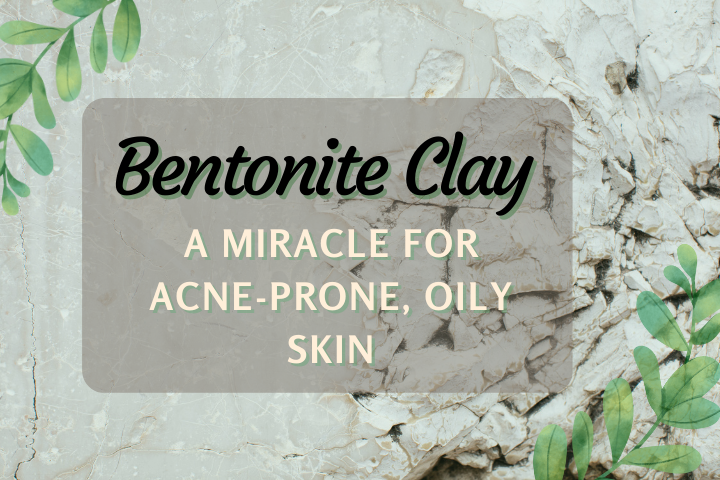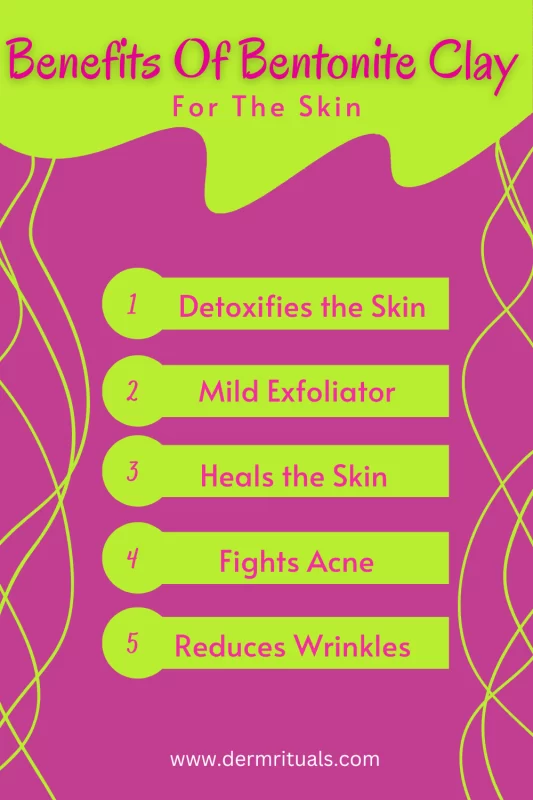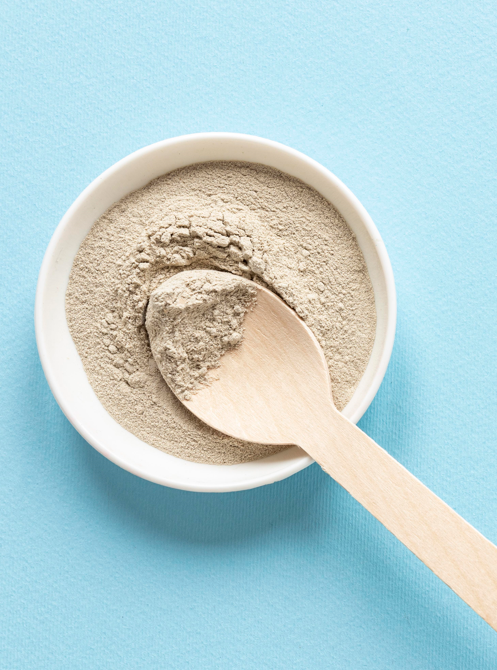Bentonite Clay: A Natural Miracle for Acne-Prone & Oily Skin

Bentonite clay is a type of clay made from volcanic ash. It is rich in minerals such as silica, calcium, iron, and potassium. It is commonly used in skin care products and as a natural remedy for digestive issues, as well as for detoxifying the body. When mixed with water, it forms a paste that can be applied to the skin as a face mask. It can also be taken orally and used as a natural remedy for digestive issues.
Furthermore, not all bentonite clays are the same, and the quality and the source of the clay can affect its effectiveness. Therefore, it’s important to use this kind of clay that is pure, natural, and from a reputable source.
Bentonite Clay Benefits For Skin:

Personally, I love using bentonite clay as it sucks out the impurities from my skin and I can feel its power. Here are some of the benefits that this clay has for the skin:
1- Detoxifying:
Bentonite clay is thought to help remove impurities and toxins from the skin, leaving it looking and feeling refreshed. It is said to detoxify the skin by binding to and removing impurities and toxins from the surface of the skin. The clay is negatively charged, and when mixed with water, it creates a negative electrical charge. When applied to the skin, the clay is thought to attract positively charged toxins and impurities, essentially “magnetizing” them out of the skin.
2- Exfoliating:
Bentonite clay is said to exfoliate the skin by gently removing dead skin cells through its fine particles. When mixed with water, the clay forms a paste that can be applied to the skin and gently massaged in circular motions. The fine particles in the clay can physically slough off dead skin cells, revealing the new and healthy skin underneath.
Do not use this clay for daily use as over-exfoliation can lead to skin irritation, dryness, and sensitivity. Use it once or twice a week as per your skin tolerance.
3- Healing:
Bentonite clay has anti-inflammatory properties. It has the ability to absorb impurities and toxins from your skin and is known to help reduce redness and inflammation, as well as soothe irritated skin.
4- Acne-fighting:
Bentonite clay got its hype from clearing out acne. It works wonderfully to reduce other blemishes as well. It has high levels of absorbent minerals such as silica, which can absorb excess oil and impurities on the skin. The clay’s ability to absorb impurities is thought to help unclog pores, reduce the appearance of acne, and improve overall skin clarity.
Some studies suggest that bentonite clay may have antimicrobial properties, which could help to reduce the growth of bacteria and other microorganisms on the skin.
5- Reduces Wrinkles:
bentonite clay is said to have high levels of minerals like silica, which is known to help improve skin elasticity and reduce the appearance of wrinkles. It can also help to improve the skin’s ability to retain moisture. But, it’s not a substitute for a moisturizer and it’s always recommended to use a moisturizer after using this clay’s mask.
Types Of Bentonite Clay:
There are two most common types of bentonite clay:

Sodium Bentonite Clay:
This type of bentonite clay has more suction power. Meaning, that it has a stronger magnetic charge that pulls out impurities from our skin. This clay is whitish-grey in color. This is not suitable for people with sensitive skin as this clay can be very drying to the skin. Sodium Bentonite clay can form lumps when mixed with liquid. Hence, it takes longer to make a smooth paste out of it. This clay is extremely absorbant so it takes double the amount of water to make its paste.
Calcium Bentonite Clay:
This type of clay is gentler form of bentonite clay. It still pulls out impurities but is less drying effect on the skin. Calcium Bentonite clay can be mixed with water easily to form a paste consistency. It has less drying effect on the skin, can even be hydrating. It is light green in color.
Bentonite Clay Side Effects:
Bentonite clay is generally considered safe for use on the skin, but as with any skincare product, it can cause side effects for some people. Some possible side effects of this volcanic clay are:
1- Irritation:
Although this clay is known to heal irritated skin but some people may experience skin irritation or redness after using bentonite clay. This is more likely to occur in people with sensitive and dry skin.
2- Drying:
Bentonite clay has a drying effect on the skin. Especially if used too often. This can lead to dryness, flaking, or itching on the skin surface. It’s especially important to be cautious when using this volcanic clay on dry skin or eczema. It can worsen these conditions for some people. But, for others, this clay might solve the problem of eczema.
How To Use Bentonite Clay:

It is important to use Bentonite clay correctly in order to avoid potential side effects. Here are some general guidelines for using it on your skin:
Do a patch test:
First things first. Bentonite clay has enormous benefits for your skin but only if you are not allergic to it. It is important to do a patch test to make sure you don’t have an allergic reaction to it.
Apply a small amount of the clay to the inside of your elbow. Leave it on for 5 minutes and wash it off. Wait for 24 hours to see if any redness or irritation develops.
Step#1: Mix the clay with water
Bentonite clay should be mixed with water (or apple cider vinegar) to form a smooth paste before applying it to the skin. In my opinion, apple cider vinegar enhances the benefits of this clay. But the smell of apple cider vinegar is hard to bare for most people, as it is very strong.
Unlike any other natural powder, mixing bentonite clay can take a while. Mix well until you get a smooth paste. You should avoid using metal utensils or bowls when mixing, as metal can neutralize the clay’s electrical charge. Don’t worry if it gets fizzy. It is supposed to happen.
Step#2: Apply the paste to the skin
Once the paste is mixed, apply it to the desired area of the skin, avoiding the eyes and mouth. Leave the paste on for 10-15 minutes, depending on your skin sensitivity. You will feel a pulling sensation on your skin. That’s the clay sucking all the dirt and impurities out of your skin. Some people might feel a strong sensation. As long as it is not irritating, it is good for you to use.
Step#3: Rinse off the clay
After 10-15 minutes have passed, rinse the clay off with warm water and gently pat the skin dry. Do not rub the skin.
Step#4: Moisturize
This is a crucial step. DO NOT SKIP MOISTURIZING after using bentonite clay. Bentonite clay can be very drying as it sucks out oils from our skin. Apply a generous amount of moisturizer after washing your face to reep the full benefits of this clay.
You can also use Hyaluronic Acid to provide extra hydration to the skin.
Read more … Hyaluronic Acid: You Need To Know This Before Using
To Conclude:
- Bentonite clay is an ancient ingredient that has helped in skin and body healing.
- Do not overuse bentonite clay even if your skin loves it.
- If you have dry skin, do not use it at all, as it can be very drying.
- Make sure to do a patch test when trying something new on your skin.
Read more about this clay here: Bentonite Clay for Skin: Benefits and How to Use


